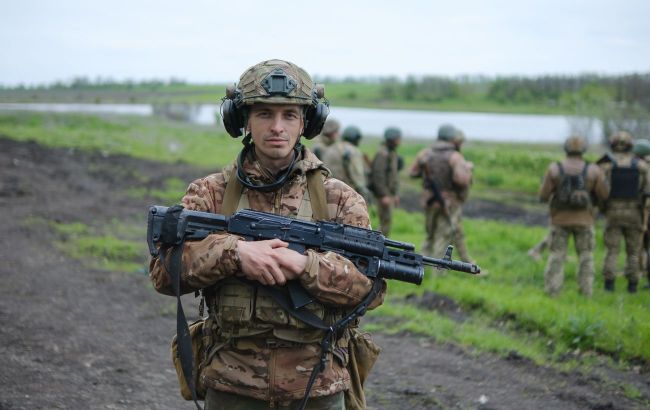Crimea bridges strikes are part of Ukrainian counteroffensive campaign, ISW
 Ukrainian military (Vitalii Nosach, RBC-Ukraine)
Ukrainian military (Vitalii Nosach, RBC-Ukraine)
The strikes on critical Russian ground communications facilities, including bridges in occupied Crimea, by the Ukrainian Defense Forces a part of the Ukrainian interdiction campaign focused on setting conditions for future decisive counteroffensive operations, according to the report by analysts at the Institute for the Study of War.
Strikes on the Сhonhar and Henichesk bridges
Ukrainian forces struck two key road bridges along critical Russian grounds lines of communication (GLOCs) connecting occupied Crimea and the occupied Kherson region on August 6, causing Russian forces to reroute road traffic from shorter eastern routes to longer western routes.
The Kherson region occupation administration head Vadimir Saldo claimed that Ukrainian forces launched 12 missiles at a road bridge across the Henichesk Strait connecting Henichesk Raion to the Arabat Spit and that Russian air defenses intercepted 9 of the missiles.
Russian sources amplified images showing significant damage to the bridge and claimed that Ukrainian strikes partially collapsed a section of the bridge. Russian sources amplified footage showing Ukrainian forces striking the Chonhar road bridge along the M-18 (Dzhankoi-Melitopol) highway connecting occupied Crimea with the occupied Kherson region and subsequent minor damage to both sides of the bridge.
Crimean occupation head Sergei Aksyonov claimed that Ukrainian forces launched two missiles at the bridge and that one missile made it through Russian air defenses and damaged the roadbed of the road bridge.
Russian sources claimed that Ukrainian forces used Storm Shadow cruise missiles to conduct both strikes, although ISW has yet to observe confirmation of Russian forces intercepting Storm Shadow cruise missiles.
Consequences for Russian logistics
Aksyonov announced that repair work is underway at the Chonhar bridge and that Russian officials will reroute all traffic through the Armyansk and Perekop checkpoints along the M-17 (Armyansk-Oleshky) and T2202 (Armyansk-Nova Kakhovka) highways.
The Crimean occupation transport ministry announced that all traffic through the Dzhankoi checkpoint along the M-18 highway is closed but that traffic along the Kerch Strait bridge and the Kerch Strait ferry crossing is operating normally.
The Russian Federal Security Service (FSB) suspended civilian entry to the Arabat Spit as of July 31, and Russian officials have not commented on the status of traffic along the Henichesk-Arabat Spit GLOC.
The ISW reports that the extent of the damage to the bridge across the Henichesk Strait is likely forcing Russian forces to redirect military traffic from the Arabat Spit to longer western routes between occupied Crimea and the occupied Kherson region.
The M-17 highway passes through Armyansk before branching at a junction with the T2202 highway to the north and continuing to the northwest, meaning that most if not all Russian road traffic between Crimea and the Kherson region will have to pass along or very close to one 20km section of the M-17 between Ishun and Armyansk.
"This major bottleneck in Russian GLOCs will likely pose significant disruptions to logistics and chances for delays and traffic jams. It is unclear how quickly Russian officials will be able to repair the Chonhar bridge and it is equally as unclear if Russian officials have repaired the Chonhar railway bridge that Ukrainian forces struck on July 29," the report reads.
The damage to the Henichesk Strait bridge will likely take Russian officials substantially longer to repair. Russian GLOCs along the T2202 northwest of Crimea - especially routes along primary and trunk roads south of Nova Kakhovka - are closer to Ukrainian positions in the upper Kherson region and in many cases within artillery range of the Ukrainian-held western bank of the river.
"Russian forces likely can reduce risks from Ukrainian indirect fire in this area by taking slower and less efficient village roads northeast of Chaplynka, but at the cost of slower and more complicated logistics support," experts at ISW write.
Part of Ukrainian counteroffensive campaign
Ukrainian strikes on bridges along critical Russian GLOCs are a part of the Ukrainian interdiction campaign focused on setting conditions for future decisive counteroffensive operations.
A prominent Wagner-affiliated Russian milblogger argued that the Ukrainian strikes on August 6 show that Ukrainian forces are methodically trying to cut off the Russian grouping in southern Ukraine and disrupt its logistics in a way similar to the Ukrainian interdiction campaign during the Kherson counteroffensive.
The milblogger noted that Russian defenses on the west (right) bank of the Kherson region broke down in a matter of days following months of Ukrainian strikes on Russian logistics and expressed concern that the situation could repeat itself.
Ukrainian Armed Forces expand interdiction efforts
The Ukrainian strikes on the eastern crossing points will likely disrupt the transport of Russian personnel, materiel, and equipment from occupied Crimea to critical Russian defensive operations in the western Zaporizhzhia region and the Zaporizhzhia-Donetsk regions border area for some, undetermined, time.
Ukrainian forces appear to be also expanding their interdiction efforts to target Russian naval targets involved in Russian logistics in the Black Sea as ISW has previously observed.
Ukrainian officials have routinely stated their commitment to a deliberate interdiction campaign against Russian military targets to degrade Russian logistics and defensive capabilities to set favorable conditions for future Ukrainian counteroffensive activity.

Key takeaways:
- Russian forces conducted one of the largest missile and drone strike series on Ukraine in recent months on the night of August 5-6.
- Ukrainian officials stated that Ukrainian air defenses have destroyed 3,500 aerial targets since the beginning of Russia’s full-scale invasion of Ukraine on February 24, 2022.
- International talks aimed at drafting the main principles for a future settlement to the war in Ukraine continued in Jeddah, Saudi Arabia on August 6.
- Kremlin Spokesperson Dmitry Peskov gave an unclear and contradictory answer to a New York Times reporter who asked whether Russia seeks to conquer more Ukrainian territory beyond the four partially occupied regions that Russia illegally annexed in September 2022.
- Ukrainian forces continued counteroffensive operations on at least two sectors of the front on August 6.
- Russian forces conducted offensive operations along the Kupyansk-Svatove-Kreminna line, near Bakhmut, along the Avdiivka-Donetsk City line, in the Zaporizhzhia-Donetsk regions border area, and in the western Zaporizhzhia region August 6 and made advances in certain areas.
- Russian military command finally allowed personnel of the Russian “Alga” volunteer battalion – which has been involved in the most intense combat on the frontlines in the Donetsk region since the fall of 2022 – to return to Russia on leave.
- Russian occupation authorities in Ukraine continue establishing institutional linkages between Russian and Ukrainian governance structures and social services in occupied Ukraine.
Ukrainian strikes on Crimean Bridges
On August 6, the Ukrainian military announced that they had struck the Chonhar and Henichesk bridges - key transportation routes for the occupiers.
Previously, on July 29, Ukrainian Defense Forces also reported a successful attack on the Chonhar bridge. Prior to this, collaborators claimed to have "repelled a Ukrainian attack" using Storm Shadow missiles against the railway in Chonhar. However, photos of the damaged crossing later emerged on the internet, indicating a different scenario.
The first strike on the bridge occurred on June 22. Russia also initially claimed the attack was carried out using Storm Shadow missiles, which was later confirmed by the Ukrainian General Staff.

